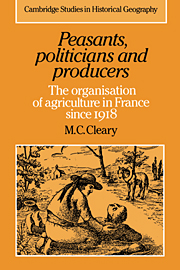Book contents
- Frontmatter
- Contents
- List of figures
- List of tables
- Preface
- Abbreviations
- Base map of the départements of France
- Introduction
- 1 The transformation of rural France
- 2 Individuals and associations in the farming community
- 3 Agricultural associations before 1914
- 4 The heyday of the regional unions, 1918–1930
- 5 The economic crisis and the rise of corporatism, 1930–1940
- 6 Agricultural associations under Vichy, 1940–1944
- 7 A rural revolution? Syndicates and cooperatives, 1944–1965
- 8 The deceptions of progress, 1965–1985
- 9 Representing the community – the place of salaried labour and women
- 10 Conclusion
- Notes
- Bibliography
- Index
9 - Representing the community – the place of salaried labour and women
Published online by Cambridge University Press: 28 October 2009
- Frontmatter
- Contents
- List of figures
- List of tables
- Preface
- Abbreviations
- Base map of the départements of France
- Introduction
- 1 The transformation of rural France
- 2 Individuals and associations in the farming community
- 3 Agricultural associations before 1914
- 4 The heyday of the regional unions, 1918–1930
- 5 The economic crisis and the rise of corporatism, 1930–1940
- 6 Agricultural associations under Vichy, 1940–1944
- 7 A rural revolution? Syndicates and cooperatives, 1944–1965
- 8 The deceptions of progress, 1965–1985
- 9 Representing the community – the place of salaried labour and women
- 10 Conclusion
- Notes
- Bibliography
- Index
Summary
Two particular groups, women and the salaried worker, have been almost totally absent from the activities of most agricultural organisations. Yet their role in the process of agricultural change has been of enormous significance. The salaried worker has been particularly important in certain farming regions but his or her status and position in the community has rarely been fully recognised by the major farming groups. Equally the role of women has been central to French agricultural development, both for the multiplicity of economic tasks they have performed and for the part they have played in such issues as the rural exodus and economic change. It is worth reiterating the fact that the favoured farming unit of the early 1960s, the two-labour-units farm enshrined in the legislation and characterised as units of male labour, required as much input from the female as the male member of the farming family.
Salaried labour in French farming
The place of salaried workers in French farming constitutes something of an enigma. A vital and numerically important part of the agricultural community in the middle of the nineteenth century, they increasingly disappeared from view as statisticians and commentators sought to emphasise the emergence of a peasant France for political and social reasons. Yet, as Table 9.1 shows, salaried workers played, and continue to play, a not inconsiderable role in French farming despite the powerful image of a nation anchored to the family farm employing primarily family labour.
- Type
- Chapter
- Information
- Peasants, Politicians and ProducersThe Organisation of Agriculture in France since 1918, pp. 150 - 166Publisher: Cambridge University PressPrint publication year: 1989

